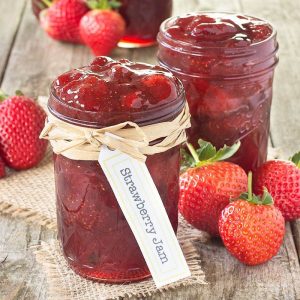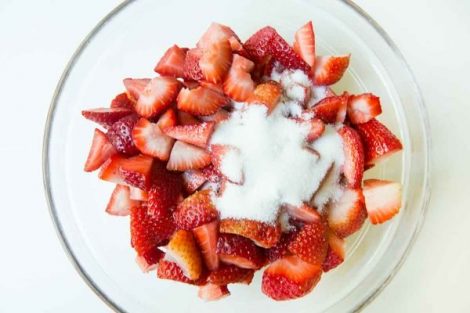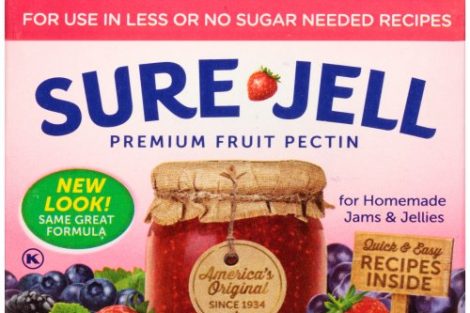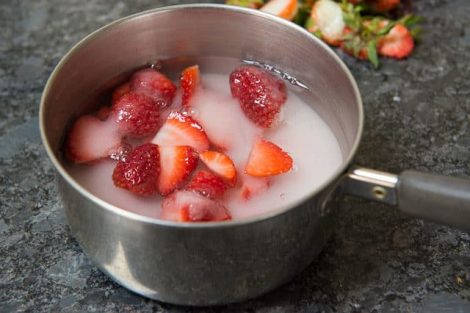
The Chemistry of Jam
Introduction and Background Info
The jam recipe provided in the Time and Activity chart contains 4 very simple ingredients: Sugar, Strawberries, Water and Pectin. A lot of the chemistry comes from that of Pectin, of which I have summarized below:
Pectin was first isolated by French chemist Henri Braconnot in 1825 and was named from the Greek pektikos, which means congealed or curdled. Pectin is a polymer and is made up of long chains of sugar molecules. In fruit, pectin is found in the skins and cores where it acts as structural support in the plant cell walls. In jam, pectin combines and traps the sugary liquid and cradles suspended pieces of fruit. (Connelly, 2013)
The molecular structure of Pectin “creates a three-dimensional network” that gives the jam its signature texture, a thicker, chunkier substance than that of its Jelly counterpart. In a solution, pectin is reluctant to form long chains because it is more attracted to water molecules than each other. The carboxyl side chains form hydrogen bonds with water molecules and water removes a Hydrogen from the carboxyl group making the pectin negatively charged, wanting to repel each other. Because sugar is hydroscopic, it removes the water and allows the pectin to congeal and set. To solve the first problem we add sugar, which binds to the water molecules and frees up the pectin chains to form their network. The negative charges are reduced by acid naturally found in the fruit. (Connelly 2013)
The value of sugar in the Jam making process is further explained in Compound Interest’s article, “The Chemistry of Jam-Making”. As mentioned prior, the sugar content, which is vital for the flavor also plays a role in helping jam set. Additionally, sugar acts as a preservative, by binding water molecules to the sugar, reducing the amount of water available in the jam, and reducing its water activity.(Compound Interest, 2014)
Additional information on the chemistry of Pectin and other ingredients can be found in the following link: https://i1.wp.com/www.compoundchem.com/wp-content/uploads/2014/09/The-Chemistry-of-Jam-Making.png?ssl=1
Scientific Explanations
As one can tell by the above description, the acidity of the Strawberry, which has a pH of 3.0, as well as the addition of sugar, allow for bonding to occur. That said, one must be careful not to add anything too acidic to Pectin however, as it will damage it. In other words, in a mixture as simple as this, there lots of Chemistry happening.
There are several ways of telling when your jam has set and you are ready to pour. It normally forms at around 104-105C, when the sugar content is high enough to allow the pectin branches to join. However, another useful method is to pour a little blob of jam on to a cooled saucer, let the jam cool in the fridge and then push against the side of it with your finger. If the surface wrinkles it means the pectin network has solidified. (Connelly, 2013)
Part of the trial and error process when trying new recipes is in all the failed attempts. While Jam is a relatively simple mixture with minimal ingredients, a lot can still go wrong. It must be said that the boiling process is the most important step as if you don’t boil it long enough the pectin network will not form properly. If boiled for too long you can lose the fresh flavor and color of homemade jam as well as having a jam with the texture of set honey.(Connelly, 2013)
Scientific Adjustments
While it is quite evident that Pectin is a vital contributor to the process of making Jam, one could make it without any pectin at all, using fruits with high pectin values, such as apples, cranberries and grapes. As mentioned earlier, Pectin is found in the skins and cores of all fruit, so in some instances, Pectin itself may not be required for some recipes. If one were to use a fruit with a lower pectin value (blueberries, cherries, peaches), then add 2 tablespoons of lemon juice in order for the network to form. An article by Healthfully describes why one may want to omit Pectin from various recipes as for some people, an allergic reaction occurs, making pectin a substance to be avoided. Like any other allergen, after pectin is ingested, your immune system overreacts to the substance and unleashes various chemicals to fight it off. When this occurs, tissues throughout your body become inflamed, leading to common allergic reaction symptoms, such as asthma and skin rashes. (Marks, 2017).
In an article titled “Why do you have to add Lemon Juice to make Jam”, Janice Lewandi explains that if you are having trouble getting your Jam to set, the mixtures pH may be to high as without a little help, the pectin strands can’t come together. The addition of lemon juice lowers the pH of the jam mixture, which also neutralizes those negative charges on the strands of pectin, so they can now assemble into a network that will “set” your jam. The optimal pH for pectin gelation is between pH 2.8 and 3.5, and if not at these conditions, the jam may appear runny due to the excess water. (Lewandi, 2015).
Another adjustment that you can make to your jam recipe is by using honey as an alternative to sugar. Honey is a heathier additive that will still give the jam its unique sweetness. In an article titled “The 9 Best Substitues For Sugar in Jam and Jelly Making, Anne James writes that using honey as a sweetener to replace sugar in your jam is by far the healthiest option, second only to a sugar-free jam. Jam made with honey is an excellent choice for people who are dieting and/or just trying to eat healthier.
She provides a list as a few things to remember when using honey to sweeten your jam:
-Be sure to use raw unfiltered honey, and substitute at a rate of 7/8 cup of honey for 1 cup of sugar.
-When using honey to sweeten jam, the honey adds liquid to your jam and can result in a finished product that is watery. But, by reducing the liquid in your jam recipe by 1/4 cup for every cup of honey used will correct this problem.
-Honey can be used to replace sugar in any fruit product, including jam, jelly, and preserves.
-A good jam recipe would be made with 4 cups of prepared fruit and 1/2 to 1 cup of raw honey” (James, 2020)
James offers some inciteful tips on how to reduce sugar intake when making your own Jam, but it should be noted that one is encouraged to take risks and find the best process and ingredients that works for them. The creation of your own recipes should act as more of an art than a science, as one can continue to experiment until you find what you believe to be just right.
The other 8 substitutes for sugar can be found in the following link: https://survivalfreedom.com/substitute-for-sugar-in-jam-making/
To summarize, all 4 of these ingredients are key contributors to the science, and creation of jam. A good jam can be hard to master, but if done correctly, can provide a great spread for some toast or various desserts. Going beyond the topic of this blog, one should be further encouraged to understand the various chemical processes to even the most mundane things in our daily lives and continue to ask questions, as the things you can learn can be fascinating.


Ingredients
Instructions
-
Recipe with Process
-
Mix Strawberries and Sugar thoroughly. Set aside for 10 minutes.

-
Stir Pectin with Water in saucepan. Bring to a boil, stirring constantly. Boil for 1 minute. Remove from the heat.

-
Stir mixtures together until Sugar is completely dissolved and no longer grainy.

-
Pour into Plastic Containers; cover. Let stand at room temperature for 24 hours. Store in refrigerator or freeze extra containers. Thaw in refrigerator. Makes about 4 (1 Cup) Containers.

Notes
Work Cited (Links)
https://www.healthline.com/health/food-nutrition/how-long-can-you-live-without-food#individual-time-period
https://www.cooks.com/recipe/f27bj2fr/sure-jell-easy-strawberry-jam.html
https://www.theguardian.com/science/blog/2013/oct/03/science-magic-jam-making
https://healthfully.com/411544-fruit-pectin-allergies.html
https://www.scatteredthoughtsofacraftymom.com/quick-homemade-strawberry-jam/
https://i1.wp.com/www.compoundchem.com/wp-content/uploads/2014/09/The-Chemistry-of-Jam-Making.png?ssl=1
https://www.thekitchn.com/why-do-you-have-to-add-lemon-juice-when-making-jam-223840
https://survivalfreedom.com/substitute-for-sugar-in-jam-making/
Pictures:
https://www.yourhomebasedmom.com/wp-content/uploads/2019/06/macerated-strawberries.jpg
https://fa74d61d848a20b729bb-0251b36b713060ab3e0e8321940e01ff.ssl.cf2.rackcdn.com/0043000293220_CF_default_default_large.jpeg
www.roadtopastry.com/blog/wp-content/uploads/2016/07/Recipe-Neutral-Glaze-Pectin03-1024x683.jpg
https://www.thriftyandthriving.com/wp-content/uploads/2010/06/IMG_0291.jpg
https://charlotteslivelykitchen.com/wp-content/uploads/2017/02/Strawberry-Jam-6.jpg
https://i1.wp.com/charlotteslivelykitchen.com/wp-content/uploads/2017/02/Strawberry-Jam-4.jpg?fit=800%2C800&ssl=1
https://i2.wp.com/practicalselfreliance.com/wp-content/uploads/2018/06/Low-Sugar-Strawberry-Jam.jpg?fit=1200%2C800&ssl=1